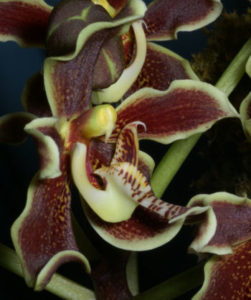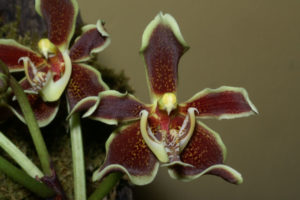The following article was written for the Orchid Species Bulletin published by the Orchid Species Society, which is based in Brisbane, Queensland in November 2010.
Bear in mind that any cultivation notes refer to the subtropical conditions of Southern Queensland, Australia.
 Paraphalaenopsis labukensis Shim, A.L.Lamb & C.L.Chan was described by Phyau Shim, Tony Lamb and Chew Lun Chan in the Orchid Digest in 1981. This species was named for the Labuk Valley in eastern Sabah, the area where the type specimen was collected. Already it is endangered due to land clearing for agriculture. The species is found on trees in hill forest above valleys between 500-1,000 m altitude.
Paraphalaenopsis labukensis Shim, A.L.Lamb & C.L.Chan was described by Phyau Shim, Tony Lamb and Chew Lun Chan in the Orchid Digest in 1981. This species was named for the Labuk Valley in eastern Sabah, the area where the type specimen was collected. Already it is endangered due to land clearing for agriculture. The species is found on trees in hill forest above valleys between 500-1,000 m altitude.
Pps. labukensis is an epiphytic plant that has very short stems with 3-5 pendent terete leaves. The leaves are 165-210 cm long and 6-9 mm in diameter. In cultivation, the leaves have been recorded as exceeding 2 m in length and have even been up to 3.5 m long!

A short pendulous to slightly upright inflorescence is produced from nodes near the base of the stem. The raceme carries 5-15 (-20) showy flowers that have a cinnamon-like scent. The flowers are clustered close to the base of the plant as the short raceme has a 3 cm long peduncle and a 4 cm rachis.
The flowers of Pps. labukensis are 4.5-6.5 cm across and have purple-cinnamon sepals and petals speckled yellow with greenish-yellow edges. The lateral sepals have purple dots on the inner half. Externally the lip is orange, gradually becoming greenish white towards the base. Internally it is white at the tip, becoming yellow at the base and is attractively marked with orange-purple dots and dashes.
Eric Christenson (1995) says that Paraphalaenopsis prefer wet conditions with steady, even watering such as is usually provided to true Phalaenopsis. The secret to good growth and flowering is apparently plenty of water. He says that in cultivation the plants have no particular preference for growing upright or pendently. They can be grown in pots, on slabs with some moisture-retentive substance at the roots such as sphagnum moss, or in baskets. Eric prefers to grow plants in a small basket with the basket at an angle and the plant semi-pendent from the side. He continues to say that the species prefer cattleya light levels and will do well in a warm or intermediate greenhouse, provided that under such conditions it does not become excessively hot.
